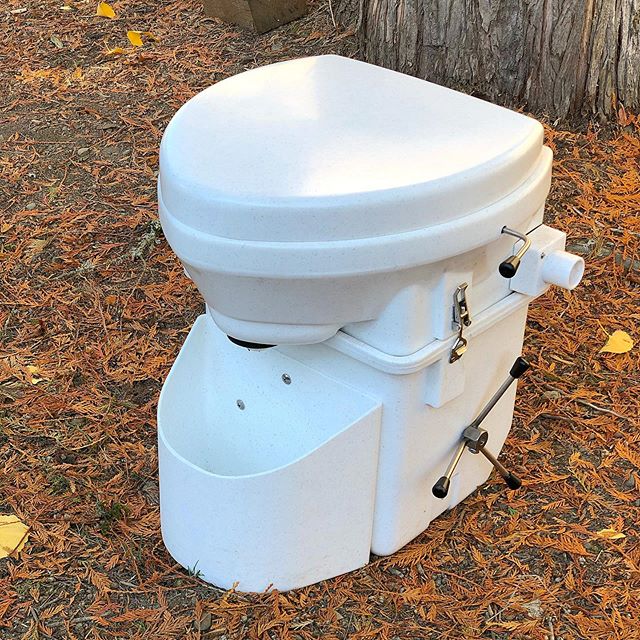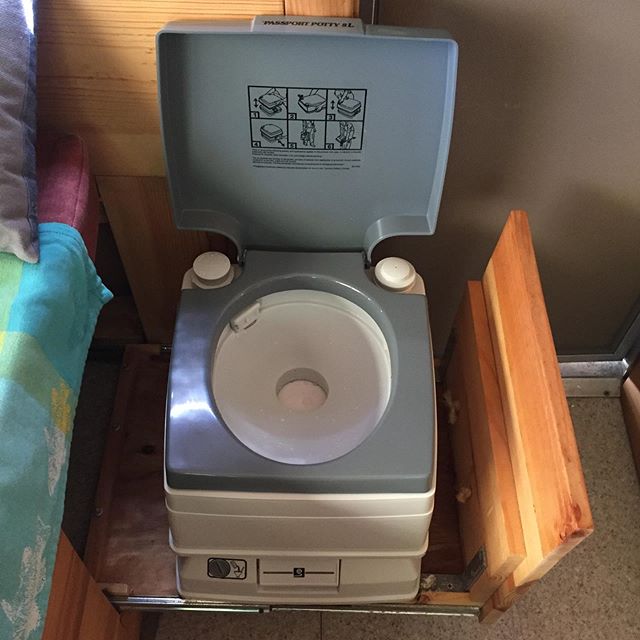
When you picture yourself setting off in your newly converted campervan, wind in your hair and a thirst for adventure, you don’t imagine the slightly less glamorous conundrum of where to go. If you’re thinking of getting a van or you already have one, you’ll know it’s one of the first questions asked. How do you handle the toilet situation and what is the best portable toilet option?
Quick Answer: There are three types of toilet you can choose from; a composting toilet, a cassette toilet or a bucket toilet.
(This is not including the bear grylls, off-the-beaten track toilet that includes you, a shovel and a 6-8 inch deep hole in the ground)
So, which one will work best for you? Let’s check out some of the pros and cons of each toilet, including smell, installation, ease-of-use, how you dispose of waste and price.
Composting Toilet

(photo: reflectionswithrivets)
How do composting toilets work?
Although they may look similar to a home toilet, they work very differently. They have two compartments below the seat, one for liquids and one for solids. They have to be separated in order to work as efficiently as possible and reduce odor, so there’s no cutting corners in this department.
Going number 1 is simple, it goes into a designated department and then if you need to go number 2, you simply pull a lever and the solid waste department is opened up. This area is filled with composting material such as peat moss or coco coir. Once your business is complete you need to turn a crank on the side that mixes the composting material and waste together.
Do composting toilets smell?
A common concern when going on the road is the smell. This type of toilet requires a 12v electricity supply thanks to the small ventilation fan that is also installed. A fan that may just save you from some pretty gnarly odors! This, coupled with the separate waste departments and lid, should keep odors to a minimum in your van.
Some people have a spray bottle filled with vinegar, water and even essential oils that can be spritzed into the basin after each use to keep it smelling fresh.
How do I install a composting toilet in my campervan?
If you’re tackling a DIY campervan conversion you might be concerned about the installation process of a composting toilet. Luckily, it’s a relatively simple process. The toilet will be stationary so make sure to plan this into your build if you can.
All the components you need should come with your toilet, including brackets for anchoring it to the floor (no-one wants to feel like bambi on ice skates while they’re trying to go!).
You will need to cut a small 2-3 inch hole either in the wall or floor of your van for the exhaust pipe to run outside and there will need to be a 12v connection to your electrical system. As long as you have those two parts down, you’re good to go (no pun intended)!
What do I do with toilet paper and how do I dispose of waste?
Both of these are super valid questions that we get all the time. You CAN throw your toilet paper straight into the toilet however this isn’t usually the method adopted by hardcore van duellers because it’ll fill up your waste tank fast! Instead most people have a separate trash can for toilet paper. This is not as gross as it sounds. If you’ve ever travelled in SE Asia you’ll remember the countless signs telling you toilet paper should be put in the bin. You get used to it quickly!
Disposing of waste with a composting toilet is very simple. The number 1 tank will need to be emptied every few days and can be put down a regular toilet, simple! The number 2 tank can last up to a few weeks with proper maintenance and that needs to be emptied into a trash bag and thrown in the dump.
How do you clean it?
Okay, once you’ve disposed of your waste in the proper manner all you need to do to clean it is use a little environmentally-friendly soap, some water and a good old fashioned toilet brush! Yep, that really is it.
It’s not recommended to use strong chemicals in a composting toilet because it can lead to bad smells and you won’t be able to dump your waste in regular toilets and dumps.
How much does a composting toilet cost?
Although composting toilets are the most environmentally friendly, they’re not the most economically friendly and can take you back around $1000.
Pros/Cons
Pros:
• Environmentally friendly
• Can go weeks without dumping
• Not too smelly
• Uses very little water and electricity
Cons:
• Quite expensive
• Involves some installation
• Cannot be moved around easily
Cassette Toilets

(photo: cedarnomad)
How do cassette toilets work?
Otherwise known as a camping toilet or portable toilet, this option is most like a regular home toilet, hence why it is so popular. They work using a black water tank underneath the seat. This collects your waste and combines it with some form of disinfectant or chemical that breaks it down into liquid form.
Once it’s full, you empty and repeat. Most cassette toilets have some kind of traditional “flush” system so it really does feel the most similar to home in that regard.
Do cassette toilets smell?
People are torn on this one. Some people swear they don’t and others feel like composting toilets have less odor. Using a good quality disinfectant and nice smelling cleaning spray after could help with odor.
Most people don’t complain about the smell of a cassette toilet in the van but the smell of it when dumping your waste. The smell of this when using the cassette toilet for number 1’s and 2’s has caused people to switch to composting!
How do I install a cassette toilet in my campervan?
Cassette toilets are self contained units that are fixed to the floor or wall of your van. You then need to make a hole in the side of your van for the “cassette” to be removed and emptied from and you need to connect to the van’s water system for the flush.
If you don’t fancy cutting holes in the side of your van, you can go for a “portable” toilet which isn’t fixed to the floor. You add the water manually on this type. This option doesn’t involve any installation, except finding a good spot to place your new toilet!
What do I do with toilet paper and how do I dispose of waste?
With a cassette toilet fixed to the floor, you’ll go out of your van, open up the hatch and remove the black water tank. The portable option means you have to remove the black waste tank and carry it through your van to empty. Both options have their pros and cons, it depends how often you’ll use your van and what level of convenience you want.
Once removed you can then simply dump your waste in a public toilet or black waste dump site. Some chemicals used in these toilets cannot be placed down public toilets because it can mess with the plumbing system, so be sure to do your research on the best chemicals to use.
How do you clean it?
Once emptied, you can disinfect with your preferred cleaner and scrub. Then just refill the disinfectant tank and water (if it’s a portable type). Most people say that using strong disinfectants make the smell in your van worse, but if you’re just using your cassette toilet for number 1’s and are emptying it regularly this shouldn’t be needed.
How much does a cassette toilet cost?
A simple cassette toilet can cost you as little as $60! This is great news if you’re looking to upgrade a little from your current bucket toilet but don’t want anything too fancy. Alternatively, a tried and tested super-duper cassette toilet can set you back up to $600.
Pros/Cons
Pros:
• Easy to remove waste tank
• Disinfectants reduces smell
• Cheaper than composting toilets
Cons:
• Can be extremely smelly when emptying
• Uses harsh chemicals
• Has to be emptied every couple of days
Bucket Toilets/Pee Bottles

(photo: ourvanfarley)
How do bucket toilets work?
Bucket toilets are the simplest option for a campervan toilet. It pretty much does what it says on the tin. It’s a simple bucket with a black bag that, once you’ve done your business, you just remove the bag and throw it away! There’s no chemicals or composting element to it so it’s as simple as you can get once you’ve outgrown hole digging!
Pee bottles are an even simpler alternative if you’re planning to use public bathrooms most of the time. You can use a bottle to relieve yourself (number 1’s only please!) and then just clean out the bottle when you reach a public toilet. Rinse and repeat. Just please, please make sure the lid is on right!
Do bucket toilets and pee bottles smell?
Short answer: yes. Of course they do. There’s no disinfectants to mask the smell or elements that break down waste so it will smell pretty bad until you throw it out. One way to reduce the smell is to have some kind of kitty litter, peat moss or sawdust to put on top of your…stuff…to minimize the odor before you throw it out.
If you’re going for the pee bottle option, you can get specially designed pee bottles with seals that can help prevent odor.
How do I install a bucket toilet?
Hurrah; a win for the bucket toilet! There’s no installation. Just chuck that bucket wherever you want. Okay, please don’t literally do this, it could get messy, but you get the idea. Place it somewhere nice and discreet and put a bag inside and there you go, installation complete.
What do I do with toilet paper and how do I dispose of waste?
With this type of toilet you don’t need to worry about a separate bin for toilet paper, just throw it right in the bag and tie it all up together. Disposing of waste should happen as soon as possible after using the toilet to prevent bad smells but you can dump your waste in any garbage can meant for dog poo or diapers which is pretty convenient.
How do you clean it?
With use of the right bags, you shouldn’t have to do much cleaning of the actual bucket. Just have some kind of cleaning spray to hand and a toilet brush so you can give it a good scrub every now and again.
How much does a bucket toilet cost?
This is, of course, the cheapest option. You can buy a standard bucket toilet for as little as $20. For a “higher end” option with a good seal and lid, you’re looking at around $30-$40. Then you have to factor in the cost for bags and some kind of odor-repelling agent.
Another option to make it even cheaper is good old DIY! All you need is an old bucket (make sure it’s big enough for you to sit on comfortably though!) and some kind of foam padding or something for the rim because…ouch! You could probably DIY a bucket toilet for around $5 if you tried hard enough. And a pee bottle is even cheaper, a couple of bucks for a Gatorade and you’re golden.
Pros/Cons
Pros:
• Cheapest option (other than a hole)
• Super portable
• No installation
• Possible to DIY it
Cons:
• Can smell
• Has to be emptied daily
• Requires bags and some kind of sawdust or peat moss
• Not a good seal or no seal at all
• Easiest to knock over
Composting Toilet vs Cassette Toilet vs Bucket Toilet: Which one is right for me?
It can feel overwhelming to try and answer this question but there are some easy questions you can ask yourself to figure this out. Will you be living in your van full-time? If the answer is yes, a composting toilet or cassette toilet is probably a must. Are you on a VERY strict budget? Go for a bucket toilet and see how it works out for you before splashing out on a more permanent option.
All you can really do is look at your budget, your space and your personal priorities and make the best choice for you.


Leave a Reply